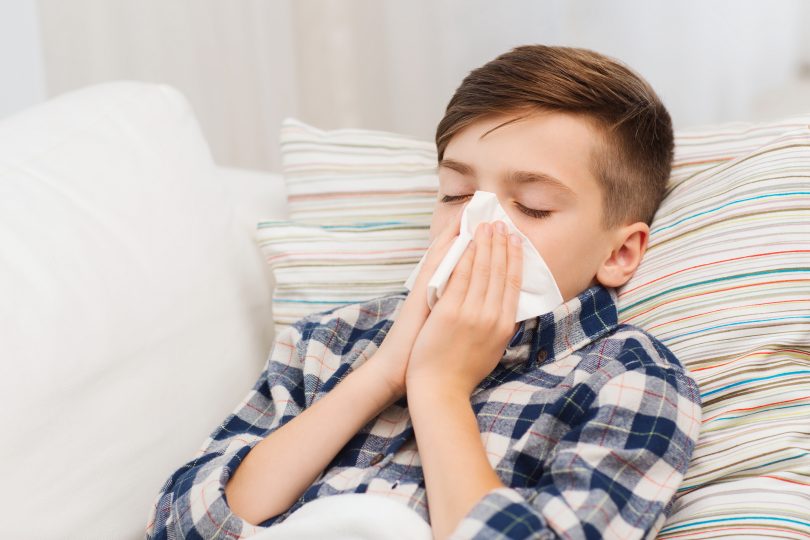Most people choose not to get the flu shot because they’re fairly young and healthy. Fair enough.
But what about the people around them?
Think Contagion, the disaster film with Matt Damon that depicted an avian flu epidemic. While that’s extreme, how flu is transmitted is exactly how it was shown in the film—by touching and breathing in the air around a person with the flu virus.
Even if you don’t care about possibly getting sick and feeling really bad for a week or two, not getting the vaccine means you could be a possible carrier for flu and infect your family, friends, coworkers and others.
“If you’re around older adults, younger children or babies, or pregnant women, you run the risk of you giving it to them and it puts them in danger, especially if they haven’t had the flu shot or if they can’t get the flu shot,” said Dr. Bruce LeClair, a family medicine physician at Augusta University Health.
Higher Risk
Sometimes we talk about the flu in the same way we talk about having a cold.
But last year, in one of the deadliest flu seasons in the United States since 1976, 80,000 people died from the flu, most from lung complications. “Eighty-five percent of those were adults over 65,” said LeClair, “and 183 were children. The majority of those—80 percent—were not vaccinated.”
Again, that’s extreme. But it’s still a fact that adults over age 65 and children—especially those younger than 5 who have smaller airways—are at higher risk for dying or going into the hospital because of flu.
At the biggest risk are newborns under 6 months because they can’t get the flu shot.
Other groups include pregnant women and people who live in nursing homes or long-term care facilities. Experts aren’t sure why, but American Indians or Alaska Natives are also at higher risk for flu complications.
Certain medical conditions can also put people in the higher risk category:
- Asthma as well as chronic lung disease, such as COPD or cystic fibrosis—since flu can lead to additional lung problems and respiratory failure;
- Neurological and neurodevelopmental conditions like brain and spinal cord disorders, cerebral palsy, epilepsy, stroke, muscular dystrophy or spinal cord injury;
- Heart disease, including congenital heart disease, congestive heart failure and coronary artery disease;
- Blood disorders like sickle cell disease;
- Diabetes and other endocrine disorders;
- Kidney and liver problems;
- Metabolic disorders
- Diseases that weaken the immune system, like HIV, cancer or being on chronic steroids;
- Extreme obesity, with a body mass index of 40 or more.
The Facts About the Vaccine
The flu vaccine isn’t a 100 percent guarantee against getting the flu. Each year, a new version is developed for the strains of flu virus that are most likely to cause problems. Still, if you happen to get sick even after getting the shot, your illness likely won’t be as severe.
Then there’s this: For the 2016-2017 flu season, the U.S. Centers for Disease Control and Prevention reported that getting the flu shot prevented 5.3 million illnesses, 2.6 million flu-related doctors’ visits and 85,000 hospitalizations.
It’s also a fact that the more people get the flu shot, the wider the net of protection, thanks to a phenomenon known as herd immunity. “It refers to the fact that people who get a vaccine can actually help protect those who can’t or haven’t been immunized,” said LeClair. “So when flu comes into a community, they can’t get sick, so they can’t give it to others who might be at higher risk.”
The CDC recommends that anyone over 6 months old get a flu shot. In addition, if you’re older than 65, you also need to make sure you’ve had your one-time Prevnar or pneumococcal vaccine, which protects from diphtheria or other pneumococcal illnesses.
The flu vaccine is available as a shot and a nasal spray. The spray does contain live vaccine (the shot doesn’t), so it’s not recommended for pregnant women, adults 50 or older and people with certain medical conditions since there is a higher risk of developing the flu from the spray. While the CDC says children older than 2 can use the nasal spray, the American Academy of Pediatrics recommends the shot for all children, with the spray only as a last resort.
People older than 65 can also ask for the higher dose flu shot, which can reduce flu infections in this age group by 25 percent over the regular shot. “It’s four times stronger than the regular flu shot because those of us over 65 have a little less effective immune response,” said LeClair.
Shot or Not
Still, whether you get the flu shot or not (but if you’re older than 6 months, you definitely should), regular handwashing is important to help you stay flu-free. Especially if you are around people who are sick or have been in a public place, always wash hands before you eat or touch your nose, mouth or eyes.
If you’re looking at percentages, the flu vaccine is usually around 60 percent effective. Handwashing and wearing a mask have been found to be between 10 and 50 percent effective. So if don’t want to get sick—and don’t want to get people around you to get sick? Your best bet is to get the flu shot.




